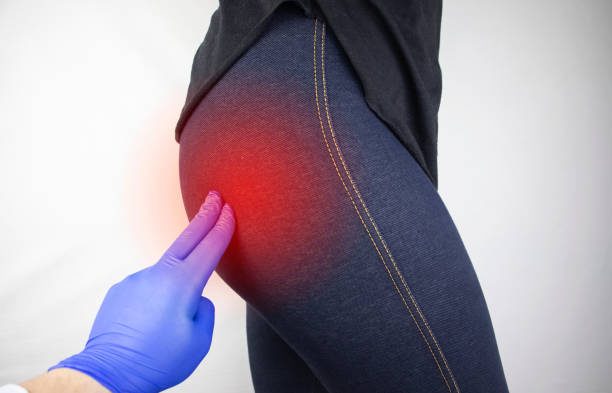Piriformis syndrome is a condition whereby the piriformis muscles in the buttocks disturb or afflict the sciatic nerve. It is an unusual neuromuscular disorder that is caused anytime the piriformis muscles constrict the sciatic nerve.
It is a disease of a narrow muscle located in the buttocks. The piriformis is a flat, band-like muscle found in the buttocks close to the top of the hip bone. This muscle is very essential because it aids in lower body movement and it also helps to stabilize the hip joints and helps in the lifting and rotating of the thigh away from the body. This enables us to walk, switch our weight from one foot to another, and retain balance.
It is also heavily used in sports that entail lifting and rotating the thighs. To cut the story short, it is used in every motion that affects the hips and legs.

Introduction to Piriformis Syndrome
You might be aware of Sciatica, a sharp discomfort that begins from the buttocks, and moves down one or both legs. Sciatica is often induced by placing a lot of pressure on the nerves in the lower back. One of the numerous disorders that induce pressure on those nerves is called Piriformis Syndrome.
The piriformis is a muscle that stretches from the front of the sacrum. The sacrum is a bone between the hip bones in your pelvis, and it is triangle-shaped. The muscle spans from your sciatic nerve to the top of the femur. The femur is the huge bone in your upper leg.
The piriformis aids the thigh in sideways movement. A piriformis muscle spasm can exert a lot of pressure on the sciatic nerve and result in discomfort. The result is Piriformis syndrome.

Causes of Piriformis Syndrome
The piriformis is used in everyday activities. It is used during walking or turning the lower part of the body. Merely switching the body’s weight from one side to another makes use of the piriformis. The muscle can get injured or irritated due to inactivity for a long time. Too much exercise can also injure the piriformis. Some of the things that cause damage to the piriformis are;
- Overexertion from excessive workouts.
- Running and other repeated actions that involve the use of the legs.
- Sitting for long periods.
- Repeated lifting of heavy objects.
- Repeated stair climbing.
Other forms of injuries that can result in piriformis syndrome are listed below. These injuries cause the piriformis to compress the sciatic nerve. These injuries include;
- Abrupt turning or twisting of the hip.
- A terrible fall.
- Taking a direct blow while playing sports.
- Car accidents. (Other vehicle accidents can also result in the injury of the piriformis).
- A deep piercing wound that reaches the piriformis muscle.
Apart from the causes listed above, there are some other things that can result in piriformis syndrome and they include;
- Sitting for long periods of time (either in front of a desk or a television).
- Participating in repeated, harsh lower body exercises.
The above set of people also have a high risk of having piriformis syndrome.

Symptoms of Piriformis Syndrome
Sciatica is often the major symptom of piriformis syndrome. It may differ with the individual and you may encounter other types of symptoms. However, the pain is often felt in other parts of the body, like the back of the legs. This is often called referred pain.
Other usual symptoms and signs of piriformis syndrome include:
- Feelings of numbness and tingling in the buttocks that may move to the back of the legs.
- Feelings of softness in the muscles of the buttocks.
- Inability to sit comfortably.
- Sharp, acute pain that gets worse the longer you remain sitting.
- Discomfort in the buttocks gets worse the longer you perform your activities.
In some severe cases of piriformis syndrome, the discomfort in your buttocks and legs can be so serious it can disable you. You might become unable to perform simple, everyday tasks and activities like sitting in front of a computer, driving, and performing household tasks.
Piriformis Syndrome Diagnosis
While there is no particular test for piriformis syndrome, in several cases, there have been reports of trauma to the area. This is often caused by repeated, intense, and harsh activities such as long-distance running or sitting for prolonged periods of time. Diagnosis is sometimes made through the patient’s complaints, and reports of symptoms. It can also be done physically through the use of various movements to induce pain to the piriformis muscle.
Often, a contracted or tender piriformis muscle can be discovered through the physical exam. Your doctor will also review your medical history, your symptoms, and other possible causes of pain. Open up to your doctor and discuss your symptoms in detail without missing one. If you had a fall recently or sprained a muscle while playing sports, tell everything to your doctor.
Due to the fact that symptoms may be similar to other conditions, radiologic tests such as MRIs or CT scans may be needed to rule out other causes of sciatic nerve constriction, for example, a herniated disc or arthritis.
Cost of Piriformis Syndrome Treatment
The cost of treating piriformis syndrome is fairly high. The average cost was determined to be about $29,070 which included a hospital stay of about 4 days, according to Wikipedia. However, it is quite tragic that most people who suffer from piriformis syndrome often experience relapses and flare-ups that put them back into the situation over and over again.
However, with better treatment and some changes and adjustments to lifestyle and daily activities, it is quite possible to beat piriformis syndrome. Failure to heed the doctor’s advice can result in permanent nerve damage, so it is advisable and imperative to follow every instruction given by the doctor to avoid complications.
Also, since piriformis syndrome is often caused by sports or activities that involve repetitive actions such as running, jogging, and lunging, it is advisable to stay away from them to avoid relapses or flare-ups. Avoid running uphill or exercising on rough surfaces.
Piriformis Syndrome Treatment
While piriformis syndrome can be treated using heat and cold therapy, or sometimes by taking corticosteroid injections or anti-inflammatory medications. However, some severe cases might require surgery before the patient can get back into their daily activities.
- Surgery:
- Treating piriformis syndrome through surgery is often tagged as the last resort by doctors because it is often used to treat severe cases. There are two methods of performing piriformis syndrome surgery.
- One of them entails making an incision where the piriformis muscles connect to the top of the femur.
- The other type of surgery involves cutting through the piriformis muscle in a region close to the sciatic nerve to relieve pressure. Piriformis surgery is sometimes performed under anesthesia or a spinal anesthetic.
- The process of the surgery would often start with the doctor making a small cut in your buttocks. After the piriformis muscle has been located, your doctor will make a cut on it. The area where your doctor cuts the piriformis muscle will be decided on by you and your doctor a day before the surgery. In other cases, your doctor might suggest that only a small part of your piriformis muscle be removed.
- Physical Therapy:
- The use of physical therapy as a method of treatment for piriformis syndrome can aid in alleviating the discomfort and pain that often accompanies piriformis syndrome.
- Physical therapy can help you quell spasms in the piriformis muscle, which in turn helps reduce tension on the sciatic nerve. Stretching exercises for piriformis syndrome can also aid in lessening the tension that is placed on the sciatic nerve and alleviate the pressure on the piriformis syndrome.
- Braces:
- Oftentimes, nonsurgical treatment for piriformis syndrome might be recommended. One of such treatments includes the use of braces. Wearing a brace can aid with posture and alignment, this, in turn, helps to alleviate tension on the piriformis muscle and sciatic nerve.
- A brace also gives compression therapy to increase blood circulation and reduce stiffness. You can wear a brace anytime while performing your daily tasks or while working out to lessen symptoms.
Apart from the methods listed above, some other ways of treating piriformis syndrome include:
- Stay away from positions that spur pain.
- Take a lot of rest anytime you can.
- Ice, heat, and elevation techniques may also help relieve symptoms.
- Osteopathic manipulative treatment can also be used to relieve pain.
- Anti-inflammatory medications and muscle relaxants might also be recommended.
- Over-the-counter painkillers such as ibuprofen (Advil) or naproxen (Aleve) also help to alleviate pain.
In other cases, a TENS (Transcutaneous electrical nerve stimulator) device may be used. A TENS device is a handheld device that sends tiny electrical charges through the skin to the nerves hidden underneath. The electrical charges stimulate the nerves and interfere with the pain signals sent to the brain.
Exercises for Piriformis Syndrome
Below are some exercises that can be performed to treat piriformis syndrome.
Hip Rotator Stretch
- Lay on your back while bending both knees and keeping your feet flat on the floor.
- Place the ankle of the affected leg on your opposite thigh close to your knee.
- Use your hand to gently push your knee (of the affected leg) away from your body until you can feel a slight stretch around your hips.
- Maintain the stretch for 15 to 30 seconds.
- Repeat the exercise 2 to 4 times.
- Change legs and repeat the steps from 1 to 5.
Piriformis Stretch
- Lay on your back while keeping your legs straight.
- Raise your affected leg and bend your knee. With your other hand, reach out across your body and then slowly pull your knee toward the opposite shoulder.
- Maintain the stretch for about 15 to 30 seconds.
- Perform the exercise with your other leg.
- Repeat the workout 2 to 4 times on both sides.
Lower Abdominal Strengthening
- Lay on your back while keeping your knees bent. Ensure your feet is placed flat on the floor.
- Pull taut your belly muscles by pulling your belly button in towards your spine.
- Raise one foot away from the floor and bring your knee toward your chest, so that your knee is straight above your hip and your leg is bent while forming the letter “L”
- Raise the other knee up to the same position.
- Lower one leg at a time back to the starting position.
- Keep alternating between both legs until you have raised each leg around 8 to 10 times.
- Ensure your belly muscles are taut and your back remains still while you are moving your legs. Remember to breathe normally.
Natural Remedies for Piriformis syndrome
Natural remedies to treat piriformis syndrome include; physical exercise, use of nonsteroidal anti-inflammatory drugs, stretching exercises, and massages.
Drugs such as ibuprofen might be recommended to deal with the pain, discomfort, and inflammation. Other medications such as Tylenol will aid you in dealing with the pain but will not reduce inflammation. Other forms of remedies include taking Piriformis syndrome injections. Some types of injections can temporarily alleviate the pain from a swollen or irritated piriformis syndrome.
Medications like Lidocaine are often given to the patients during the course of receiving injections. This helps to put the piriformis muscle in a relaxed state, thereby temporarily lessening the pain and discomfort.
There are lots of medications that can be injected directly into the piriformis muscle to aid in recovery and relieve the pain and discomfort that is felt. Your doctor would determine what type of piriformis injection would be suitable for you.
Piriformis Syndrome Prevention
As piriformis syndrome is often caused by sports or activities that repeatedly burdens the piriformis muscle, such as running or lunging, prevention can be achieved by staying in good form. Do not run or perform exercises on hills or rough surfaces. Warm-up before starting any exercise and gradually increase the intensity. Keep a good posture while running, walking, or exercising. If you feel pain, halt the exercise and take a rest until the pain subsides.
However, while intense exercise can result in piriformis syndrome, performing soft exercises regularly can reduce the risk of having piriformis syndrome. Your muscles need to remain strong and active. In order to prevent injuries that might lead to piriformis syndrome, do not hesitate to do the following:
- Always warm-up and stretch for a good amount of time before you start running or engage in strenuous exercises.
- Do not rush to increase the tempo of your exercises. Gradually increase the tempo of whatever workout you engage in.
- Desist from running up and down steep hills, or any rough or uneven surfaces.
- Move around a bit and stretch whenever you have feelings of numbness in your legs.
- Get up and move around anytime you feel like you have been sitting for long periods without any activity.
Conclusion
Piriformis syndrome is not a usually seen condition and can be extremely tough to diagnose. It can often be treated through rest and physical therapy. Make sure you stay active and do not forget to stretch before exercising. This would help to keep your backside and legs feel better before the workout, during the workout, and after the workout.
If you feel any numbing or tingling sensation in the area surrounding your buttocks, do not hesitate to see your doctor. While the pain your feel might not necessarily be a result of piriformis syndrome, but it is better to be safe than to be sorry. Piriformis syndrome is to be treated as soon as it has been diagnosed.
If you have previously been treated for piriformis syndrome, you may have a higher risk of it happening again. If you follow and perform the exercise like your doctor recommended, and perform more physical therapy, you would be able to avert a relapse except you have a serious injury.


